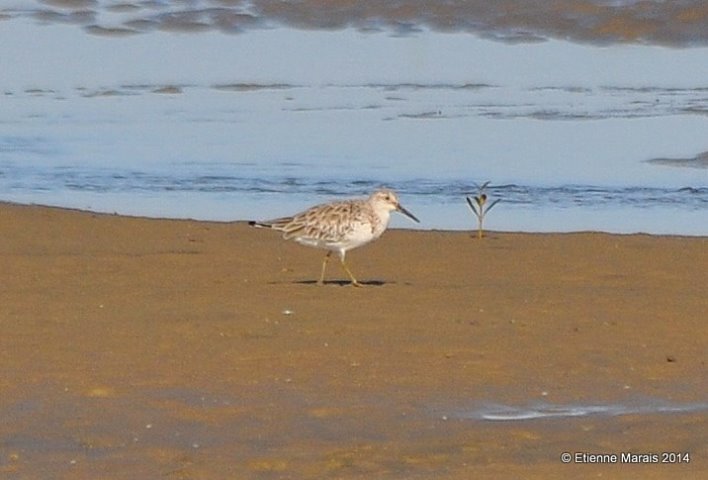
Mozambique Birding | Birding and Tour News | Features | Listing Clubs | Enquire
Birding South Africa | Birding Johannesburg/Pretoria | About us | Contact us | HOME
 |
Day Trips | Weekend Birding Events | Scheduled Tours | Customised Tours | Birding Courses Mozambique Birding | Birding and Tour News | Features | Listing Clubs | Enquire Birding South Africa | Birding Johannesburg/Pretoria | About us | Contact us | HOME Indicator BirdingErectile Dysfunction | |
Great Knot recorded again in Mozambique.One of the big rewards of visiting the Inhambane estuary is the vast numbers of shorebirds present. The sheer size and innaccessibility of most of the estuary makes it very hard to cover all the possibilities, but on out trip in April/May we worked hard to scan the waders in search of something different.After some hard work, we located a single Great Knot on the estuary side of the Barra Peninsula near Inhambane on the 28th of April, 2014. Before more comphrehensive analsysis of the bird in question could be undertaken, it took off and flew into the long-off distance - as waders tend to do in this vast area. We waited again in the same area on the next day (30 April) and as if on cue, the bird was located feeding in the same area again. We were able to get confirmation and also some images of the bird, which was actually much more co-operative the second day round.  Initially the bird was picked up due to it's unique GISS - clearly larger than most of the smaller waders about. It had quite an elongated build with relatively long bill. On first sighting it was only just within range to see that it had bold markings on the chest, but nothing like some of the other Great Knot images one finds on the Internet. Frustratingly, it flew off across the vast estuary - only showing a very whitish rump/uppertail coverts. Initially the bird was picked up due to it's unique GISS - clearly larger than most of the smaller waders about. It had quite an elongated build with relatively long bill. On first sighting it was only just within range to see that it had bold markings on the chest, but nothing like some of the other Great Knot images one finds on the Internet. Frustratingly, it flew off across the vast estuary - only showing a very whitish rump/uppertail coverts.
 On the second day we could see the features better and these included dark feather centres on the coverts and mantle and bold streaking on the crown. There were strong blotches on the side of the chest making up a visible chest band. In addition there were some diffuse markings on the flanks as well. The bill looked long and at time clearly drooping at the end (I understand that the bills are flexible so thus may not look quite the same shape at all times). In flight the whitish uppertail coverts were obvious with only some diffuse markings. The overall structure of the bird was elongated and the primaries appeared to extend well past the tail. On the second day we could see the features better and these included dark feather centres on the coverts and mantle and bold streaking on the crown. There were strong blotches on the side of the chest making up a visible chest band. In addition there were some diffuse markings on the flanks as well. The bill looked long and at time clearly drooping at the end (I understand that the bills are flexible so thus may not look quite the same shape at all times). In flight the whitish uppertail coverts were obvious with only some diffuse markings. The overall structure of the bird was elongated and the primaries appeared to extend well past the tail.
Interestingly SA guides seem to emphasize leg color and play down differences in rump/uppertail coverts (anyone know why?). Red Knot does not occur on the Mozambique coast, so any Knot's should be checked for Great Knot !! Faansie Peacock picked this species up at Barra in 2004 and it was recorded again in 2008. This is only the 5th record of the species for Southern Africa, but given the size and challenge of birding the vast estuary of Inhambane, it may in fact be more regular in the area. The location was on the inside of the estuary, opposite Areia Branca Lodge at Ponta da Barra in Mozambique. This area is innaccessible at high tide and one needs to plan visits around the tide. According to the Rare Bird report issued by Trevor Hardaker: This species was first identified in the subregion in March 2002 at Seeberg in the West Coast National Park. Subsequent investigation revealed that it had in fact been visiting this site from late 2000. It returned to the same location for several seasons and was last reported in late 2003. The second record was in December 2004 when a bird was located on the Barra Peninsula near Inhambane in Mozambique whilst the 3rd record came from the same site in September 2008 and concerned up to 3 individuals. The 4th record came from Namibia in later November 2008 when a single bird was discovered there and there has then been a 5,5 year drought before this most recent record. Next year (April 2015) we will be back at this location, and will also try and locate the Green Tinkerbird discovered in January last year. (see here for more information on this amazing discovery) last year. |